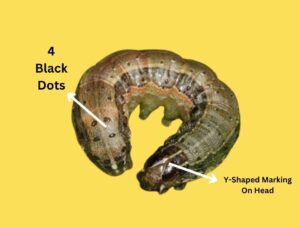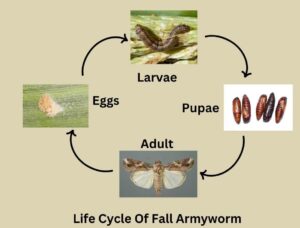Fall Armyworm
Fall Armyworm(FAW) also known as American Fall Armyworm is voracious pest which commonly feeds on maize plant causing huge loss to crop production. Fall armyworm has now emerged as one of the epidemic in agriculture and food sector. Million hectors of land where maize is cultivated has totally affected and destroyed by fall armyworm. Despite the fact that the favourite crop of FAW is maize, It do attack and feed on other crops like:- Wheat, Paddy, Millet, Sugarcane, Sorghum, Cotton, Vegetables.
Fall Armyworm was first noticed in Western Hemisphere Of America, So called as the indigenous pests of America and Canada. It is believed that, In 2016 America has exported large amount of corns to other parts of world which leads to the entry of FAW in different countries especially in Africa. What happened there was, the eggs and larvae of the Fall Armyworm has also transported along with the corns. From Africa, The pest entered into Iran followed by South East Asian countries like China, India, Pakistan, Nepal. Though the pest isn’t indigenous to Africa and Asia, It has become invasive in the region of introduction. Invasive Pests are the those pests which cause extensive damage and are difficult to control.
It is called ‘Armyworm’ because During the larval stage, individuals gathers in huge masses forming like an Army which destroy the crop in short duration.
There is one interesting fact of the FAW. Whenever the there is a scare in feed, the older larval instars feed on younger larval instars. This is a type of cannibalism which helps to overcome the problem of food scarcity.
Classification
This pest fall under the Lepidoptera order and Noctuidae family. The scientific name is Spodoptera furgiperda. Being in Noctudiae family, It is mostly active at Night and can be controlled using light traps.
Identification Of Fall Armyworm

We can identify the FAW easily by observing its larval stage. If we look closely on the dorsal side of larvae, we can clearly see 4 large dots in 8th segment. Another way to identify is to observe its head. There is a inverted Y shape marking on the head of FAW. The larvae is white or light green in colour with black head. We can also identify the presence of pest by observing the symptoms in plants. Some symptoms exhibited by the maize plant are:-
- Leaves of maize are eaten by worm and there looks like net in leaves.
- We can see many small holes in leaf of maize.
- We can also see dust like that of wood on leaves.
Nature Of Damage Of FAW
Fall Armyworm is voracious feeder which feeds mainly on leaves including stems and cobs of maize. The main damaging stages are larvae and adult. Larvae consumes by biting and chewing of all the green parts of maize excluding roots. This pest has large host range of 350 plant species. So, Its control becomes difficult. However, The major host is Maize,
Maize is the second most cultivated crop in the world. So, it feeds billions of people. It is also known as “Queen of the cereals”. As maize feeds billion of people, so we can predict that the damage caused by fall armyworm can be the reasons of death of million of people. On an average, In land area of 1 acre maize production is about (20-25)Quintal. But due to attack of fall armyworm, it gets reduced (16-18) Quintal i.e. decrease production by (20-30)%. In short, It is a harmful insect of maize crop.
The larval stage covers the small area as they can’t travel the long distance. But, the adult moth have wings and can fly up to 100 km per night. This distance can increase up to 480 km before laying eggs.
Life Cycle Of Fall Armyworm

FAW passes through four different stages before completing it life cycle in days. These four stages are:- egg, larvae, pupa and adult. The pest lays the egg in a cluster of (50-200) in underside of the maize leaves. The eggs are covered with brown scales released from the female abdomen. Eggs hatch within days which leads to the emergence of larvae. The larvae are the voracious feeder and the most destructive stage of all. After emergence, they start to feed on leaves and travel downward along the leaves towards stem. There are 6 larval instars which lasts for (14-22) days. After larval stage, The pests goes into pupation. The pupation occurs in which lasts for (8-30) days. Pupae develops into adult. Adult fall armyworm has wings and can fly long distance in short period of time and lay eggs in new plants. Adult female can lives up to 21 days.
Control Measures
Fall armyworm can be controlled easily if identified at early stage. In later stages, they are very difficult to control. Remember, we shouldn’t apply the chemical pesticide as the first approach. we should follow IPM methods for the control of Fall Armyworm. First, We should do the observation only to know the number of pests. Only when they overcome the economy injury level, we should apply chemicals. Some control measures to follow are listed below:-
Survey/Surveillance
First thing to do in management of this pest is survey. The field should be observed in W – Shape. This way we can see if the pest has attacked all the crop field or not. Then – We can determine the economic injury level and act accordingly.
Mechanical Method
🔹Deep summer tillage.
🔹Weeding should be done from time to time.
🔹Inspection of corn field should be done every week.
🔹We can collect fall armyworm in plastic and kill them with fire.
Biological Method
🔹Enemies of fall armyworm like bees, ants and birds should be preserved.
🔹Time of plantation of maize should be shift little early or late.
🔹Nitrogenous fertilizers should be applied in proper manner.
🔹Biological pesticides like NPV/Baccilus thruingiesis should be applied.
🔹Fall armyworm doesn’t like the smell of Desmodium grass. So, it should be planted in middle of corn field.
🔹Similarly, female fall armyworm likes saint of the Napier grass. So, it should be planted at the edges of field.
▪️These two (Desmodium+ Napier) forms the Push-Pull trap crop which are very effective in control of Fall Armyworm.
🔹Intercropping of peas and bean can control fall armyworm
Chemical Methods
🔹(3-5)ml of “Azadiractine 1500 PPM”should be mixed with 1 litre of water and should be applied to corn field in every 10 days.
🔹Some of the chemical pesticides effective for the control of Fall armyworm are:-
✓Spinosad
✓Spinetoram
✓0.4 gm emamectin benzoate mixed with 1 litre of water.
🔹Chemicals should be sprayed in cobs and mask and other protective equipment should be used while spraying chemicals.
Conclusion
FAW is a destructive pests. It should be controlled as early as possible. Chemicals should be used as the last option of control measure when all other methods fails. First, You should identify the pest with caution so that you don’t endup identifying some other pest as FAW.
References
https://extensionentomology.tamu.edu/insects/fall-armyworm/https://www.researchgate.net/publication/340916860_NEW_INVASIVE_ALIEN_SPECIES_IN_MAIZE_FALL_ARMYWORM_Spodoptera_frugiperda_J_E_Smith_LEPIDOPTERA_NOCTUIDAE
